
1 - Preface
1.1 - Purpose of this manual
When the general stores configuration, and item characteristics have been defined, the majority of the logistical problems can be solved automatically by means of computer programs which use generally available statistical information.
The availability of items is controlled by a number of parameters, which depend on order policies, economical considerations and item characteristics.
These item parameters must be regularly recalculated for each item in order to obtain the most reliable estimates reflecting the current situation. The calculation of the parameters is based on demand forecast, statistical fluctuations in demand and on the desired service-level of the issued items.
After optimisation of the initial set-up parameters, stores configuration, and item parameters, by simulation and production tuning, the general standard model will normally provide optimal solutions in 95 % of all the cases, by means of standard solutions to standard situations using statistical information to calculate optimal item parameters. e.g. automatic re-calculation of lead-times, economic order quantities and reorder points.
However, for an exceptional 5 % non standard situations, the general standard model and statistical methods used, may not be sufficient to provide an optimal solution, and additional information is required: e.g. when a supplier provides information about a future change of the item availability.
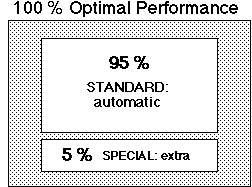
The aim of this manual is to resolve the non standard situations, where extra information is needed to provide an optimal solution.
In this manual first some concepts of the general logistical model are described, next some problems which can be solved by entering extra information are presented. How this information can be entered in the form of logical constraints is explained in detail in the last part of this manual.
1.2 - General
The logistics organisation has the responsibility for the optimal servicing of requests for items and materials, of required quality and quantities, at the desired delivery date, at the lowest cost.
The main objective of stockholding is maintaining a high service level, within the financial constraints that the total stock value should not be above certain limits but as low as possible within a pre-defined high service-level, avoiding excess of stock, and thus allowing sufficient financial space for new items to be standardised, introduced and stocked.
Requested materials can be served from stock, or alternatively by ordering directly from the supplier.
1.3 - Serving items from stock
In order to serve materials from stock, replenishment must occur to replace materials which have been issued or which are known to have future requirements.
1.3.1 - Economical order quantity EOQ
For every item an economical reorder quantity EOQ can be calculated, that will lead to the lowest total cost of ordering and stockholding. The calculation of the EOQ is based on general economical conditions such as consumption, cost of ordering and cost of holding the item in stock.
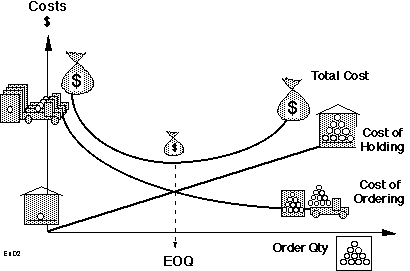
However, the EOQ calculation does not include considerations such as maximum stockable quantity, limited shelf-life, dimensions of the material other than the consumption unit, or difficulties in obtaining the material. When the item is re-ordered, other constraints such as the suppliers minimum, and multiple, are included in the re-order quantity.
1.3.2 - Reorder point ROP
Re-ordering of items takes place whenever the available stock quantity drops below a certain level, the re-order point ROP.
This reorder point ROP represents the buffer quantity of items required to ensure that material requests will continue to be served, during the time between the ordering of new material and the arrival of the ordered new material.
The time between the moment a proposition for re-ordering of new material and the availability in stock of the ordered new material is the so-called re-ordering delay or lead-time.
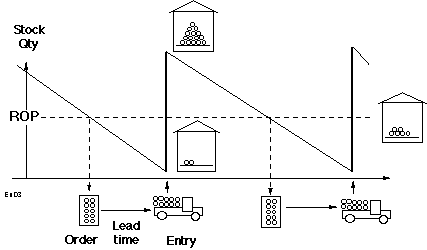
The re-order point ROP is calculated as the sum of 2 components
* A stock reserve or buffer stock quantity SR which is based on the normal average expected consumption during the lead-time.
* An extra quantity, the so-called safety or security stock SS, to ensure that the item is available up to the pre-defined required service level, even when the re-ordered material arrives later then expected, or the fluctuations in demand during the lead-time cause the demand to be larger then expected.
The safety stock is the most important component of the re-order point. The average stock value is determined for a large part by the safety stock. Good safety stock ensures a high service level.
1.3.3 - Reorder cycle and lead-time
The lead-time of the re-order cycle is composed of the following components:
1. Review time needed to confirm a replenishment proposal.
2. Time needed to process and send an order.
3. The supply time or delivery time, defined as the time needed for the supplier to deliver the requested materials after the order has been received. This time includes assembling or manufacturing, when needed.
4. Inspection and entering the item to stock.
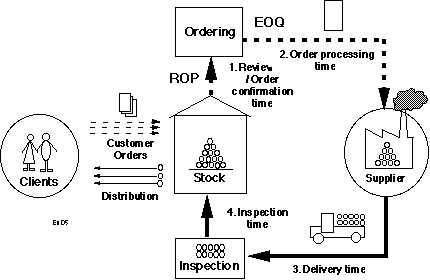
Both the stock reserve SR and the safety stock SS quantity components of the reorder point ROP are very dependent on the delivery time and the reliability of the supplier.
If the delivery time changes, this will highly influence the re-order point and thus the moment of re-ordering.
1.4 - Serving material requests by direct delivery from the supplier
Economical considerations such as short delivery time of the supplier, or low demand frequency of expensive items may lead to the decision not to keep the items available in stock, but to handle requests for these items only by direct delivery of the item from the supplier.
Direct ordering for non-stocked items can be handled electronically by electronic data interchange EDI or normal ordering by purchase orders.
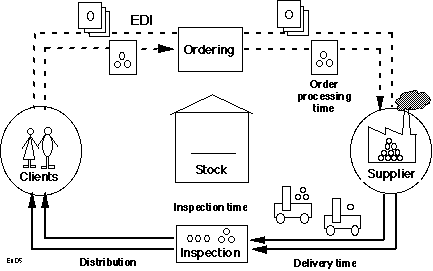
1.5 - Exceptional large non-recurrent demands.
Occasionally, material requests for exceptionally large quantities will disturb the servicing of material requests for normal quantities.
1.5.1 - Exceptional requests handling
Correct handling of these non-recurrent or infrequent exceptional requests is very important. The penalties in costs and service level can be very high if these exceptional large demands are not correctly identified and handled.
Serving a demand for an exceptionally large quantity from stock will generally lead to stock-out, and backorders for the normal requested quantities.
In order to avoid this the material requests for an exceptional large quantity can be handled by a special order.
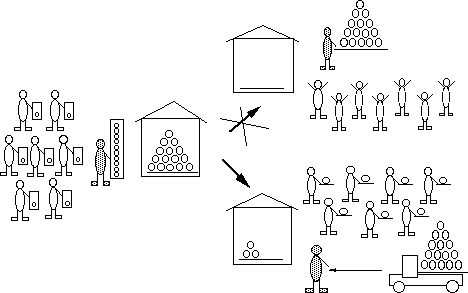
The infrequent or non-recurrent requests for exceptionally large quantities often originate from capital projects, where these material requests are planned well in advance. The non servicing of these planned materials on the requested delivery date, may disturb the project planning.
1.5.2 - Exception threshold level.
Requests for exceptional large quantities are identified by comparison of the requested quantities with a so-called exception threshold level.
If the demanded quantity is larger then this threshold level the request will be considered as an exceptional demand.
Occasionally a request for an exceptional quantity of an item can be served normally from stock, without endangering serving of the normal requests for the item. This is the case when after serving the exceptional quantity at least one re-order point is left.
Handling of requests for exceptional large quantities involves:
* Check if serving the exceptional quantity from stock will disturb the normal stock keeping.
* If the exceptional quantity can not be served from stock, a special order is created for the material request with a delivery date, such that the delivery date of the material request can be met. Notify requester if this date can not be met.
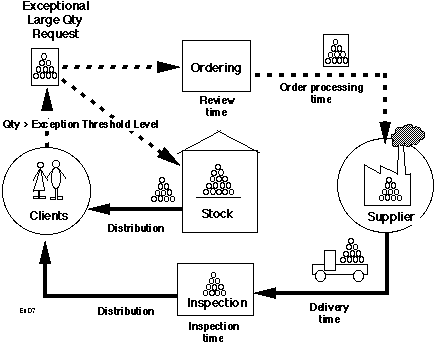
1.5.3 - Exceptional requests and safety stock
If the historical exceptionally large requests are not correctly identified for the statistical calculations, they will dominate the normal statistical requests.
The statistical domination of the normal requests by the exceptionally large non-recurrent demands may result in very high stock values caused by unnecessary high security stocks.
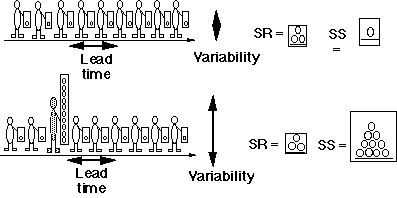
NOTE: Careful definition of the exceptional threshold value is of very important: it has a direct influence on:
* The actual stock operations
* The service level
* The stock value
2 - Logical constraints
The stockholding, reordering and exceptional handling of items are controlled by a number of logistics parameters: the reorder point, economical order quantity and exception threshold level. These logistics parameters are calculated based on a mathematical model, representing an approximation of the real world, and statistical information from a number of sources such as historical consumption, material needs of future capital projects, and the estimates of the various costs of the steps and processes involved.
However, the values calculated for the logistic parameters, can never be more accurate then the model involved and the information used.
The statistical standard model based on historical consumption will normally give very satisfactory results in 95 % percent of the cases.
However, in exceptional non-standard situations the normal statistical information (historical consumption) may be insufficient and lead to unsatisfactory results, e.g. in cases like:
* You are informed by the supplier that the delivery time (supply time) for a given item or range of items will change.
e.g. your supplier is not stocking the item anymore in the future, or there is a temporary production failure

* The product is technically sensitive: a new version is due after a certain date, or the old version is not valid anymore after a particular date (e.g. computers, calendars, agendas, etc.)
* There is a certain duration of life, limiting the shelf-life of the product (e.g. ink, markers, medicines, etc.)
* There is a non-statistical, expected growth, which is known to happen in the future.

* The dimensions of the requested piece of raw material may be more important then the quantity requested as criterion if this request can be satisfied from a given unit of raw material or not. For raw materials the statistical reorder point quantity may not be very meaningful as a means to express if a given request can still be served from this quantity or not (see picture).

The dimensions of the requested piece of material may be such that the request can only be served from a complete stock unit of the material.

If a minimum level is defined of at least one whole stock unit, the serving of a material request is ensured. If the price of the material is low, the minimum level can be taken consisting of several untouched units.
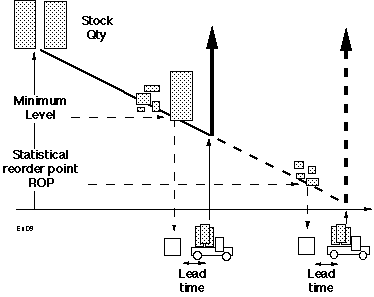
In order to cope with special situations, such as raw materials, limited shelf-life, change of delivery time, etc. , additional information can be entered in the form of logical constraints
* item shelf-life
* New version date
* Maximum stockable quantity
* Supplier delivery time + valid date
* Lot quantity
* Minimum level
* Exceptional threshold level for direct delivery
* Expected growth factor + valid date
These logical constraints will influence the moment and quantity of the reorder proposition, or the handling of the material request.
The quantity that is proposed to reorder

* Shelf-life (indirect by expected consumption in shelf-life)
* Lot quantity
* Maximum stock
* Expected growth
The moment in time on which a proposition for re-ordering is created

* Supplier delivery time (indirect by new reorder point ROP)
* Minimum level
* New version date
* Expected growth
The handling of the material requests

* Exceptional threshold level for direct delivery
3 - Logical constraints and material flow
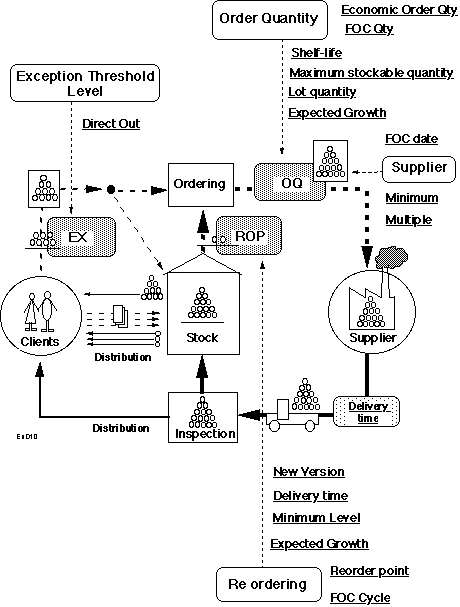
4 - Problems and solutions
The following list of problems, may easily be solved, by entering a constraint in the constraints definition screen.
PROBLEM The shelf-life of the item is limited. The consumption may not be sufficiently large to ensure consumption of the EOQ in the shelf-life. Ordering a larger quantity, than the expected consumption during the shelf-life may result in deterioration of the products in stock.
ACTION Enter the shelf-life in days,
RESULT The proposed order quantity will be adjusted according to the expected consumption in the shelf-life.
PROBLEM A new version is due after a certain date, ordering before this date will result in orders for the old version, which will soon be obsolete.
ACTION Enter date after which new version is due
RESULT The proposed order quantity will be adjusted according to the expected consumption in the shelf-life.
PROBLEM There is a maximum stocking capacity in the store for an item.
ACTION Enter the maximum stockable quantity.
RESULT The proposed order quantity will be adjusted according to the maximum stockable quantity.
PROBLEM You are informed by the supplier that there is a temporary change in delivery time due to e.g. a temporary production failure
ACTION Enter the delivery time and valid period end date
RESULT The ROP is adjusted and will reorder in time. After the valid period end date is reached the constraint and the valid end date will be automatically erased, and the system will return to the use of the statistical value.
PROBLEM You are informed by the supplier that the delivery time will permanently change in the future: e.g. your supplier is not stocking the item anymore in the future, but will only manufacture the item on request.
ACTION Enter the delivery time (entering a valid period end date in the future is recommended, since the statistical value will automatically adjust after some time).
RESULT The ROP is adjusted and will reorder in time.
ROBLEM The item is difficult to obtain, but of vital importance.
ACTION Enter a logical or desired lot quantity
RESULT The EOQ will be adjusted.
PROBLEM The item is a stocked spare part. There is no breakdown history, but to avoid costs of production downtime, a certain quantity or minimum set size is requested.
ACTION Enter a logical or desired lot quantity
RESULT The EOQ will be adjusted.
PROBLEM The item is a raw material. The statistical reorder point in issue units, is insufficient to determine a reorder point which will ensure that requests for material will be satisfied.
ACTION Enter a minimum level as one or more stock units of the raw material.
RESULT The ROP is adjusted and will reorder in time.
PROBLEM The item handling needs manual attention above a certain quantity.
ACTION Enter a quantity above which the item is considered exceptional
RESULT The requests for the item will be handled manually.
PROBLEM There is an expected growth / or diminishing of demand foreseen
ACTION Enter an expected growth factor e.g. 1.5 or diminishing factor e.g. 0.5
RESULT The effect of the expected growth will be included in the calculation of the parameters.
RPU12 - Item constraints definition
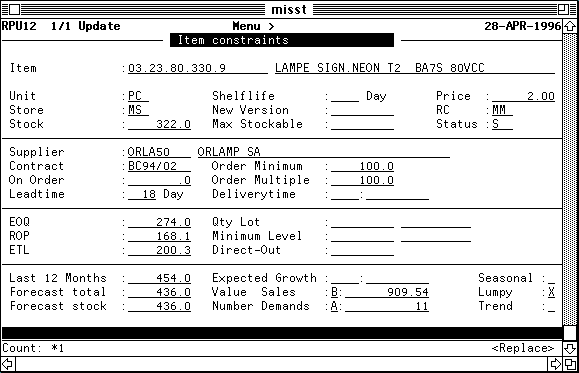
FUNCTION AIM
The purpose of this screen is to define item constraints to handle exceptional situations.
After optimisation of the set-up, stores configuration, and item parameters, the general standard model will normally provide optimal solutions in 95 % of all the cases, by means of standard solutions to standard situations using statistical information to calculate optimal item parameters. e.g. automatic re-calculation of lead-times, economic order quantities and reorder points.
However, for an exceptional 5 % non standard situations, the general standard model and statistical methods used, may not be sufficient to provide an optimal solution, and additional information is required: e.g. when a supplier provides information about a future change of the item availability.
CONSTRAINT FIELDS
Shelflife The number of days the item can be held in stock before it will not be fit for consumption anymore, e.g. it will deteriorate or corrode
New Version Date on which a new version of the item is due, the reorder point will be reset to 0, blocking the ordering until the date is reached.
Max Stockable Maximum Stockable quantity that can be stocked or that one logical wants to hold in stock.
Delivery time Time needed by the supplier to deliver the item.
Qty Lot Logical set size or quantity
Minimum Level Logical minimum
Direct Out Level above which a customer order will be turned into a special purchase order
Expected Growth Expected growth factor, e.g. for non statistical growth, caused by future planning.
The constraints entering and definition screen displays a large number of non enterable fields for information purposes. Most of these field are queryable, one can search by interrogation of the screen items for a certain supplier or contract or responsible, and may other criteria.
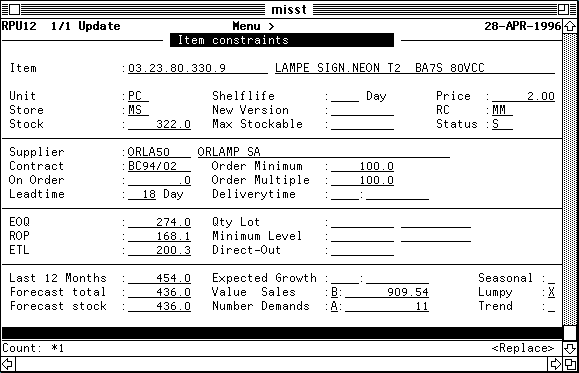
DISPLAY FIELDS
Item Unique item code and short description.
Unit Unit of measure.
Store Principal store.
Stock Stock quantity of principal store.
Price Sales price of the item.
RC Product responsible.
Status Item status.
Supplier Preferred supplier for the item.
Contract Valid contract for preferred supplier.
On Order Quantity on order for preferred supplier.
Leadtime Statistical reaorder delay of preferred supplier.
EOQ Economic Order Quantity
ROP Reorder point
ETL Exception threshold level.
Last 12 Months Consumption quantity last 12 months
Forecast total Total year forecast quantity , including exceptional demand component
Forecast stock Year forecast quantity of expected stock consumption
Value sales Last 12 months turnover value
Number demands Number of customer orders over last 12 months
Seasonal Seasonal pattern indication.
Lumpy Lumpiness indication.
Trend Trend indication.
5.1 - Additional information
Additional information can be displayed by backend menu functions. The pop-up backend menu and drill down focusing, allows
* Restriction of display of data for which the user is responsible
* Decision support by display of a full set of on-line information functions
* Pop-up backend menu containing function screens, windows and reports,

Drill down windows allow to focus on details, and additional information e.g. Order history, Suppliers statistics, Demanded Quantities Distribution.
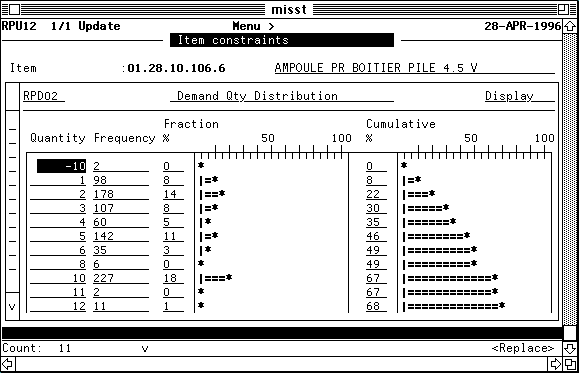
5.2 - Shelf-life
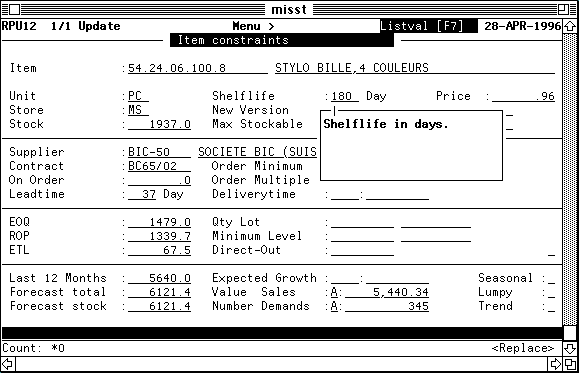
SHELFLIFE
The product may have only a limited duration of life, e.g. it will dry, corrode or deteriorate after a certain period. By entering the shelf-life in days, the proposed order quantity will be adjusted according to the expected consumption in the shelf-life.
Re-order quantity = NOT MORE than LEAST ( EOQ, EXPECTED CONSUMPTION )
NOTE: A short shelf-life may conflict with a long lead-time and minimum or multiple order conditions of the supplier.
5.3 - New version
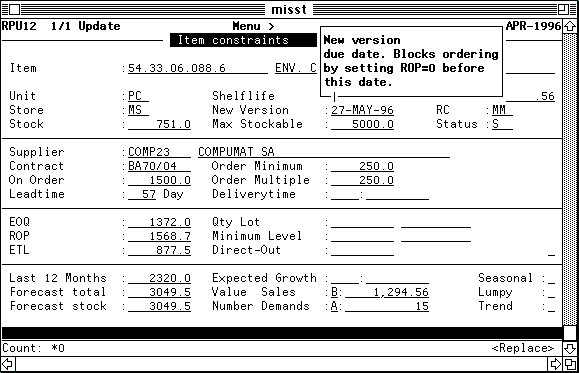
NEW VERSION
A new version is due after a certain date, or the old version is not valid anymore after a particular date.
By entering a date in the future the re-order point and re-order quantities are set to zero, thereby blocking re-ordering until after this date or after the whole existing stock is consumed.
Re-order moment = AFTER ( NEW VERSION DATE )
If however the whole stock is consumed, new requests will be turned in backorders, which will trigger a reorder proposition before the new version date, thereby focusing attention on the created backorder (s).
If the current date becomes the entered new version date, the date is automatically erased, and normal re-ordering is continued.
5.4 - Maximum stock

MAXIMUM STOCK
The physical properties of an item (e.g. volume, dangerous properties, need of a special cooling-box) may restrict the amount that can be held in stock.
Re-order quantity = NOT MORE then LEAST ( EOQ, MAXIMUM CAPACITY )
NOTE: A long lead-time and a small maximum stock capacity may conflict for a high desired service level.
5.5 - Delivery time and end validity date
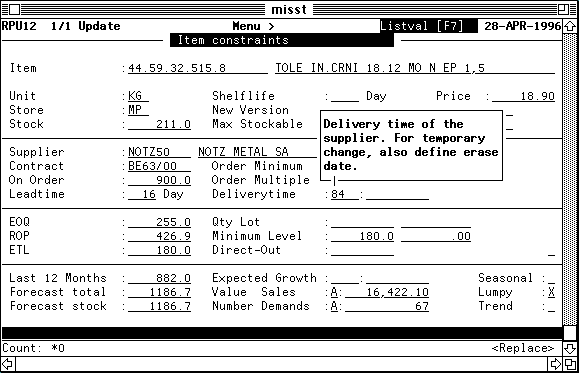
SUPPLIER DELIVERY TIME and VALIDITY DATE
The lead-time is composed of
1. Review time replenishment proposal
2. Time needed to process and send an order
3. The delivery time or supply time = time needed for the supplier to deliver the requested materials after the order has been received. This time includes assembling or manufacturing, when needed.
4. Inspection and/or assemblage and entering the item to stock
A default value for the sum of the times of 1, 2 and 4 called review time is assigned in the set-up. A value for 3. can be entered. This is particular useful if you are informed by the supplier that the delivery time for a given (range of items) will change. (e.g. your supplier is not stocking the item anymore in the future so the delivery time will be much longer, or there is a temporary production failure)
The new lead time condition, can now be calculated as sum of 1, 2, 3 and 4.
Lead time = REVIEW TIME + DELIVERY TIME
If the defined delivery time constraint should be of limited duration, a valid date can be entered, after which the constraint and the valid date are automatically erased.
NOTE: It may be also for permanent changes useful to define a valid date in the future, since the statistics will after some time adjust to the changes.
5.6 - Lot quantity
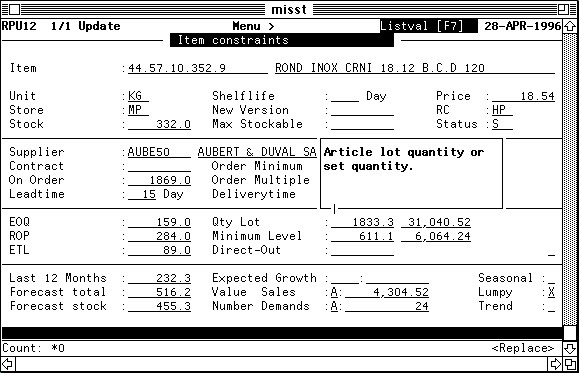
LOT QUANTITY
A lot quantity can be defined for the item, the lot is an item attribute and not a supplier condition. There may be several reasons, to define or calculate a minimum level.
Set size in equipment
The item is always needed in the same quantities, as result of the dimensions of the physical use. e.g. when the item is used as spare part, and two spare partw are always replaced together when maintaining the equipment, there will only be requests for sets of 2.
The item is a strategic material
The material is difficult to obtain, but of vital importance.
Considerations of this type these may lead to constraints such as: Take as reorder quantity a quantity equal to the last 3 years consumption.
The definition of a minimum level can lead to high stock-holding costs, and may require a signature to become effective.
A report is available which displays the additional costs imposed by Lot quantities.
these additional costs are defined by (greatest(EOQ, MIN) -LOT)*PRICE
Re-order quantity = GREATEST ( EOQ, LOT )
NOTE: The greatest condition will ensure that on rising demand, if the statistical EOQ becomes larger then the defined LOT, the correct results are ensured.
5.7 - Minimum level
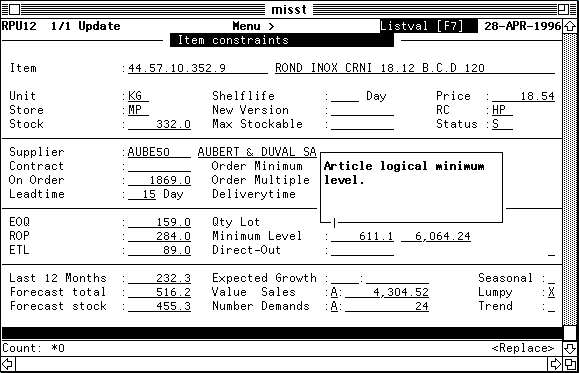
MINIMUM LEVEL
A non-statistical minimum level can be defined for the item, there may be several reasons, to define or calculate a minimum level
Capital spare parts
For spare parts there will be normally no consumption history, or very low historical consumption data available, there is however a very high penalty cost, caused by production down time, on not having the spare part at minimum level (set) at breakdown of the part in the production equipment.
Raw materials
For raw materials the statistical reorder point quantity may not be very meaningful as a means to express if a given demand can still be served from this quantity or not (see picture chapter 2). The dimensions of the requested piece of material may be such that this demand can only be served from a complete stock unit of the material. If a minimum level of at least one whole stock unit is defined, the serving of a material request is ensured. If the price of the material is low, several stock units can be taken to define the minimum level.
The definition of a minimum level can lead to high stock-holding costs, and may require a signature to become effective. A report is available which displays the additional costs imposed by minimum levels
these additional costs are defined by (LEVEL-ROP)*PRICE
Re-order at moment = GREATEST ( ROP, LEVEL )
NOTE: The greatest condition will ensure that on rising demand, if the statistical ROP becomes larger then the defined minimum level, the correct results are ensured.
5.8 - Exceptional quantity threshold level
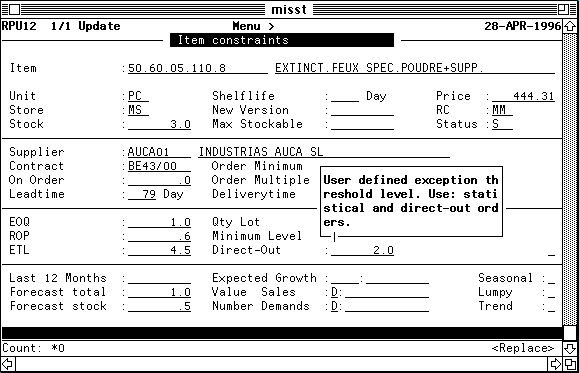
userdefined EXCEPTION THRESHOLD LEVEL
A non-statistical userdefined exceptional quantity threshold or break quantity can be entered. If this value is defined, it will be taken instead of the statistical calculated value, used to determine if a quantity demanded will be considered exceptional (marked for direct delivery) or not.
By setting it to 0 it will force all the demands to be treated as exceptional demands.
By setting it to a very high value, all the demands will be served from stock. Serving an exceptional large quantity from stock may result in stock-out and back orders.
NOTE: The user definition of the non-statistical exceptional quantity threshold will also be used to determine the statistical component of the exceptional demand.
5.9 -Expected growth and valid date
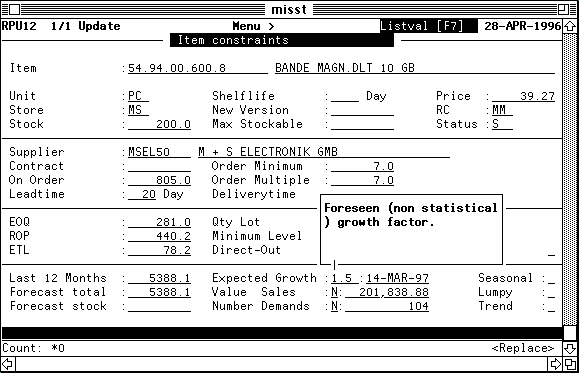
GROWTH FACTOR and VALIDITY DATE
Sometimes future changes are known, which will influence the item consumption.
E.g. when a new member state joins an international scientific organisation, more materials, A4 copy paper and toilet paper, etc. are needed. This is a non-statistical, foreseen growth.
Forecast = GROWTH FACTOR * STATISTICAL Forecast
A n expected growth factor can be entered. If this value is defined, the used values of 3 months forecast and year forecast will be multiplied by this factor.